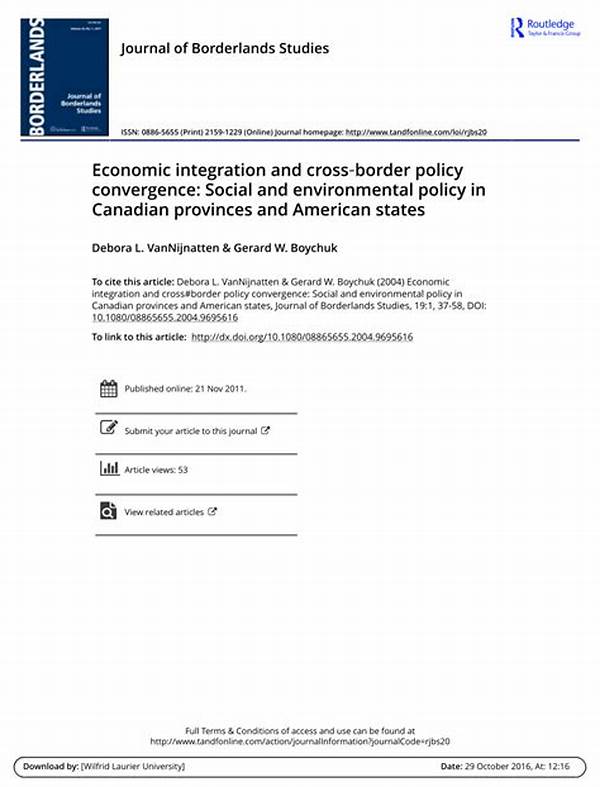In the increasingly interconnected world, cross-border policy integration has become a crucial component for nations engaging in transnational cooperation. This process involves the harmonization of policies across countries to ensure coherent and efficient interaction in political, economic, and social arenas. As globalization continues to dissolve geographical boundaries, the need for cohesive policy frameworks is more significant than ever. This article will explore the various aspects of cross-border policy integration, the challenges and opportunities it presents, and its implications for global governance.
The Importance of Cross-Border Policy Integration
Cross-border policy integration is paramount as nations share common objectives such as economic growth, security, and sustainable development. By aligning policies, countries can manage shared resources efficiently, reduce conflicts, and anticipate global challenges collectively. Economic treaties, climate agreements, and migration protocols exemplify how policy integration can harness collaborative benefits. However, this integration necessitates overcoming significant obstacles, such as cultural differences, regulatory discrepancies, and domestic political resistance. Successful cross-border policy integration fosters mutual trust, enabling countries to share best practices and reinforce diplomatic ties, leading to a more stable and prosperous global environment.
With the ever-growing complexity of global challenges, cross-border policy integration offers a strategic advantage by pooling resources and expertise among nations. For instance, environmental challenges such as climate change are transnational by nature and require a harmonized approach to achieve meaningful results. Policy integration across borders can streamline efforts in reducing carbon emissions and implementing sustainable practices. Additionally, integrated border policies enhance security measures by optimizing information-sharing and joint security operations. This cooperation helps to prevent threats such as terrorism and transnational crime. Ultimately, cross-border policy integration is essential for creating synergies that can propel collective global advancement.
Challenges in Cross-Border Policy Integration
Cross-border policy integration faces numerous challenges, including legal and institutional disparities that hinder the seamless alignment of policies across nations. Additionally, differing national priorities and geopolitical interests complicate the process, necessitating a delicate balancing act to accommodate diverse perspectives and agendas.
Cultural diversity presents another significant challenge in cross-border policy integration. Varied cultural norms and values often lead to conflicting policy priorities, requiring careful negotiation and compromise to reach mutually acceptable agreements that respect the distinct identities of participating nations.
The lack of a unified regulatory framework across borders can impede cross-border policy integration. Countries often have unique legal systems that make harmonizing policies complex. This necessitates extensive dialogue and collaboration to create flexible frameworks capable of accommodating different legal traditions.
Resource disparities among participating countries pose a considerable challenge in cross-border policy integration. Variations in economic resources and technological capabilities can hinder equitable participation, necessitating mechanisms to address gaps and ensure all parties can contribute effectively to the integration process.
Political resistance to cross-border policy integration is prevalent as domestic political pressures and national sovereignty concerns arise. Policymakers must navigate these sensitivities to advance integration efforts while upholding the integrity and autonomy of individual nations involved.
Approaches to Effective Cross-Border Policy Integration
To achieve effective cross-border policy integration, establishing robust communication channels is crucial. Regular dialogue between governments and stakeholders facilitates mutual understanding and alignment of objectives, reducing potential areas of conflict and paving the way for cooperative policymaking.
Building institutional frameworks that support cross-border policy integration enhances the ability to implement integrated policies across borders effectively. These frameworks may involve intergovernmental organizations or regional entities that coordinate efforts and provide platforms for negotiation and decision-making.
Comprehensive stakeholder engagement is essential for successful cross-border policy integration. Involving relevant stakeholders, including governmental bodies, non-governmental organizations, and the private sector, ensures diverse perspectives are considered, fostering widespread support and cooperation in the integration process.
Utilizing technology and data-driven insights can significantly enhance cross-border policy integration efforts. By leveraging technology, nations can streamline information-sharing processes, analyze data collaboratively, and make informed decisions that are based on real-time, evidence-based insights.
Promoting capacity-building initiatives is crucial to address disparities in resource availability among countries involved in cross-border policy integration. By enhancing the capabilities of less-resourced nations, all parties can contribute meaningfully, ensuring equitable participation in the integration process.
Strategic Goals of Cross-Border Policy Integration
Cross-border policy integration aims to create synergistic relationships among nations to address global challenges efficiently. By fostering a comprehensive understanding among countries of shared issues, this integration seeks to identify common goals and mutual interests for collective action.
One strategic goal of cross-border policy integration is economic synergy. By aligning economic policies and practices, nations can facilitate trade, increase investment opportunities, enhance market access, and boost economic growth, resulting in improved prosperity for all participating countries.
Security cooperation is a pivotal goal of cross-border policy integration. By harmonizing security policies and measures, countries can effectively combat transnational threats such as terrorism, organized crime, and cyber threats, contributing to global peace and stability.
Environmental sustainability is another strategic goal of cross-border policy integration. With environmental challenges transcending borders, integrated policies enable coordinated efforts to combat climate change, preserve biodiversity, and manage resources sustainably, ensuring a healthier planet for future generations.
Enhancing social cohesion represents a crucial objective in cross-border policy integration. By harmonizing policies relating to human rights, education, and healthcare, nations can foster inclusivity and equality, promoting social stability and empowering individuals across borders.
The Role of Technology in Cross-Border Policy Integration
Technology plays a transformative role in facilitating cross-border policy integration. By enabling seamless communication and information exchange, technological advancements such as digital platforms, big data analytics, and artificial intelligence support the efficient alignment of policies across nations.
Digital platforms facilitate real-time dialogue among stakeholders involved in cross-border policy integration. These platforms provide spaces for virtual meetings, negotiations, and collaborative decision-making, reducing geographical barriers and fostering continuous interaction between governments and other stakeholders.
Big data analytics enhances cross-border policy integration by providing insights into complex issues that transcend national boundaries. Through comprehensive data analysis, countries can identify trends, forecast outcomes, and develop evidence-based policies that address shared challenges effectively.
Artificial intelligence supports cross-border policy integration efforts by automating processes and analyzing vast datasets. This technology aids in identifying patterns, optimizing resource allocation, and improving decision-making accuracy, ultimately leading to better policy outcomes and more efficient implementation.
Blockchain technology ensures security and transparency in cross-border policy integration. By providing immutable records of transactions and agreements, blockchain enhances trust between participating nations and minimizes risks associated with data manipulation or discrepancies in policy implementation.
Conclusion: The Future of Cross-Border Policy Integration
As globalization continues to reshape international relations, cross-border policy integration stands as a cornerstone for fostering international cooperation and addressing shared challenges effectively. By aligning policies and fostering collaboration across borders, nations can leverage collective strengths to address critical issues such as economic development, security, and environmental sustainability.
In the future, achieving successful cross-border policy integration will require sustained commitment and adaptability. Nations must embrace innovative approaches, enhance resource-sharing mechanisms, and prioritize inclusivity to create an integrated global policy framework that reflects diverse perspectives and caters to the interests of all stakeholders involved.
The evolving landscape of cross-border policy integration signifies an era of unprecedented collaboration among nations. With technological advancements and increased interconnectivity, countries have an opportunity to redefine geopolitical dynamics and establish a more harmonious global order. The success of this integration depends on the willingness of states to transcend traditional boundaries and work collectively toward a prosperous and equitable future for all.





